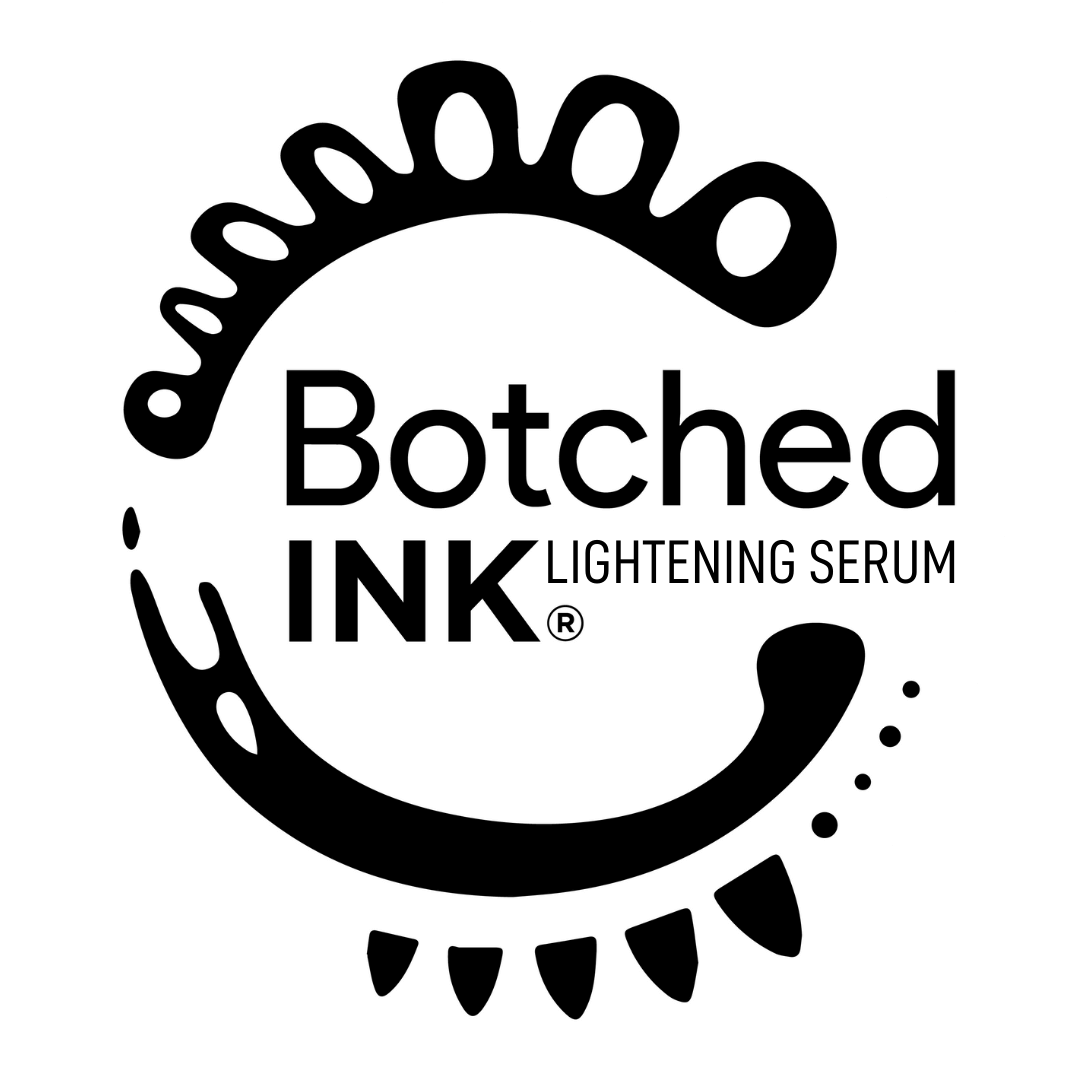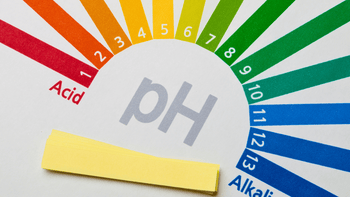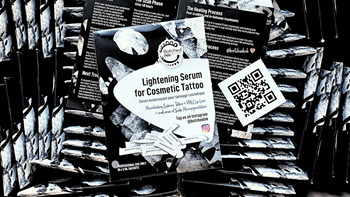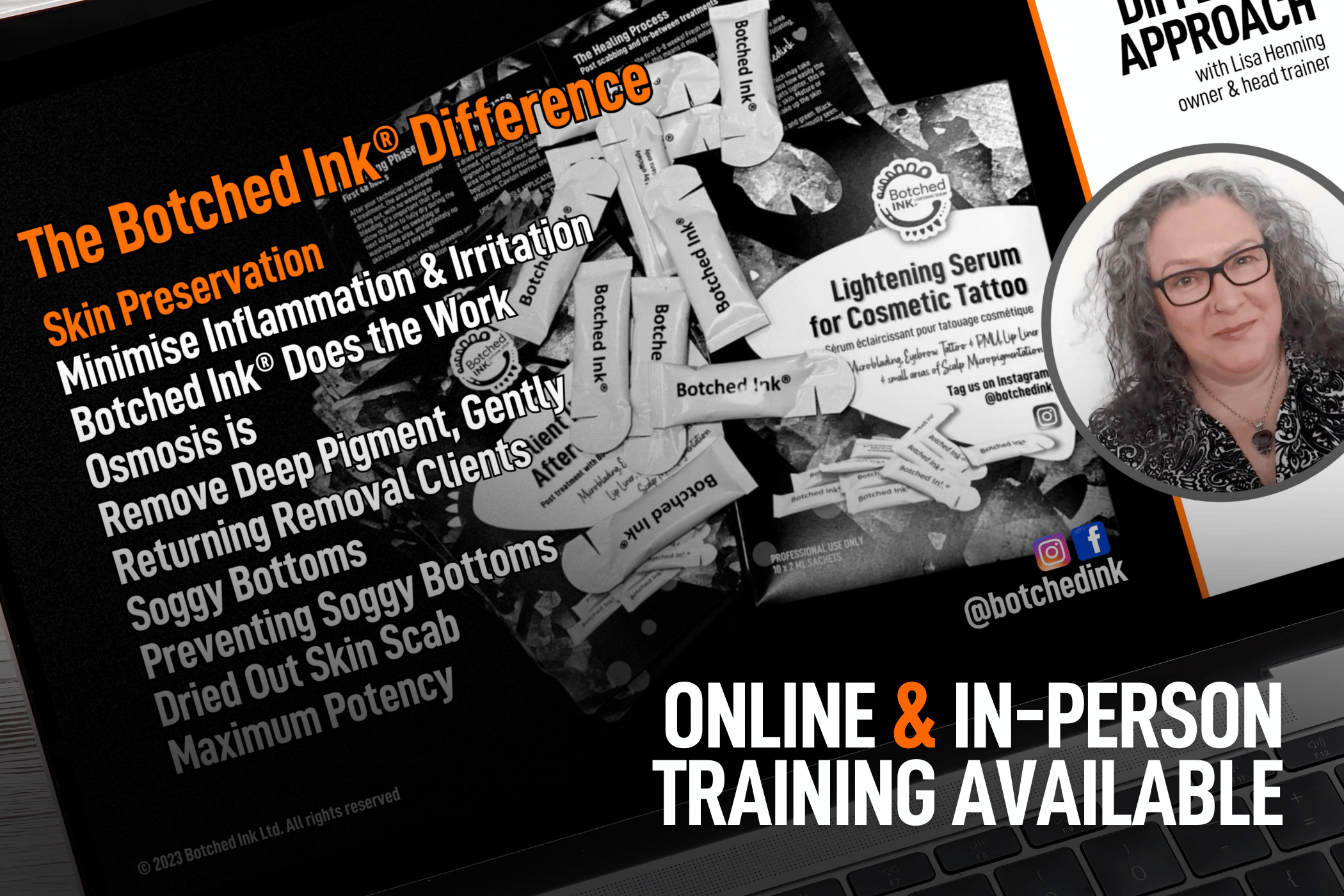TL;DR
Both Botched Ink® and LiFT remove pigment using saline osmosis. Botched Ink® incorporates wound-supportive elements to create a more stable, predictable process with minimal aftercare, while LiFT relies more directly on osmosis and multi-pass application, which can produce quicker changes in some areas but with greater variability and higher aftercare needs.
A Scientific Comparison
This comparison is intended for educational purposes, using publicly available information and general wound-healing principles. It is not intended to imply superiority or inferiority of either product, but to outline how differences in formulation and method may influence skin response and healing.
This article was written with the assistance of ChatGPT (OpenAI), acting in the role of a neutral science explainer. The focus is on skin biology, chemistry, wound-healing mechanics, packaging, and practitioner access, rather than marketing claims.
The aim is to provide a structured, evidence-informed comparison of how Botched Ink® and LiFT saline removal solutions may function in practice and are used in the industry. (Lisa note: The rest of this website is more human, take a look around!)
Abstract
Saline tattoo removal is an established non-laser method for pigment lightening. Both Botched Ink® and LiFT operate on the principle of osmosis, but differ in their formulations, packaging, method of application, and distribution models. This paper provides a structured comparison of both products, examining how these factors may influence skin response, scab formation, pigment removal outcomes, and long-term healing.
What is Saline Tattoo Removal? ➔
Find a Botched Ink® Tech Near You ➔
1. Introduction
Among the different saline removal products available, Botched Ink® and LiFT are the two most widely recognised in the industry. Both are designed for pigment lightening without laser, and both are frequently discussed by practitioners comparing methods and outcomes.
Saline tattoo removal works by creating an osmotic imbalance in the dermis. A hypertonic saline solution is introduced into the skin, causing water to move out of pigment-holding cells. This dehydrates the cells and contributes to pigment release. The skin then forms a controlled wound and scab, and pigment is expelled when the scab naturally sheds.
While both Botched Ink® and LiFT rely on this mechanism, the two products differ in how their formulas are composed, how they are delivered into the skin, and how they are controlled through packaging and practitioner training. These differences may influence how the skin responds during treatment, how it heals afterwards, the predictability of pigment removal, and the long-term condition of the treated area.
Eyebrow Tattoo Removal: Saline or Laser ➔
Permanent Makeup Removal: Pigments ➔
2. Ingredients
Ingredient information is taken from public sources, and general cosmetic chemistry and wound-healing biology. See disclaimer at the end of this paper for details.
Botched Ink®
- Dead Sea Salt (sodium chloride + minerals): Creates osmotic pull while providing magnesium (often described as anti-inflammatory), zinc (linked to cell renewal), calcium and potassium (barrier support), and bromide (antibacterial). May be gentler on skin than plain NaCl.
- Aloe Vera (200:1 powder): Highly stable, penetrates deeply, acts as a transdermal carrier, may reduce inflammation, antibacterial. Supports pigment mobility while calming irritation.
- Glycerin: Humectant, balances dehydration, supports even healing.
- Corn Starch + Aluminium Sulphate: Absorb fluid, contract vessels, reduce bleeding, encourage a dry, stable scab.
- Other functional agents: Xanthan gum (consistency), sodium hydroxide (pH adjustment), Mikrokill COS preservative system (broad-spectrum, paraben-free).
Botched Ink® is formulated to behave like a wound-care serum, balancing controlled dehydration with stability and support for healing.
LiFT Saline Removal
- Sea Salt (sodium chloride): Osmotic driver, plain NaCl without mineral balancing.
- Lemon + Orange Seed Extracts: Citrus extracts are acidic, which can increase cellular stress and sensitivity in surrounding tissue
- Aloe Vera + Calendula Extract: Provide soothing and antibacterial effects, intended to counteract irritation after it occurs.
- Hydroxyethylcellulose: Thickener, provides viscosity.
- Barium Sulfate: Inert whitening agent, increases visibility on skin.
- Sodium Benzoate + Potassium Sorbate: Preservatives.
LiFT combines osmotic stress with additional chemical irritation, followed by botanical agents that aim to reduce the resulting inflammation.
3. The Role of Osmosis
Both Botched Ink® and LiFT remove pigment through the principle of osmosis. A hypertonic saline solution has a higher concentration of salt than the fluid inside skin cells. When this solution enters the dermis, water moves out of pigment-holding cells to balance the salt gradient. This dehydration weakens cells and helps pigment particles move upward into the scab that later sheds.
Where the two products differ is in how much they rely on osmosis alone versus how much they integrate it into a broader wound-healing process:
LiFT Saline Removal
Primarily a hypertonic saline with acidic stressors.
Relies heavily on osmotic dehydration as the main pigment-lifting force.
Additional ingredients (citrus extracts) may increase stress on cells, while botanicals (aloe, calendula) mainly serve to calm irritation afterwards.
Outcome: Pigment lift is largely driven by osmotic pull and the trauma created during multi-pass application.
Botched Ink®
Uses osmosis through Dead Sea salt, but this is only one part of a more layered design.
Aloe vera and glycerin act as carriers, supporting penetration while balancing irritation.
Corn starch and aluminium sulphate immediately manage bleeding and drying, shaping the wound environment from the start.
Minerals may support cell metabolism and repair, reducing inflammation while dehydration occurs.
Outcome: Pigment lift is achieved through controlled dehydration and predictable scab formation, not osmosis alone.
In short: both products depend on osmosis, but LiFT appears to rely on it as the core driver, while Botched Ink® incorporates osmosis into a wider system of wound stabilisation and skin support.
4. Packaging & Stability
Packaging directly affects sterility, ingredient stability, and dosing consistency.
Botched Ink®: Supplied in single-use sachets. Each is sterile until opened, helping reduce cross-contamination risks. Sachets prevent repeated exposure to air and light, which can affect sensitive actives such as aloe vera powder (key transdermal carrier) and minerals. Pre-measured doses encourage consistency across treatments, and clients see fresh sachets opened in front of them, reinforcing safety and professionalism.
LiFT: Supplied in multi-use bottles. Once opened, bottles are repeatedly exposed to air and light, which may increase the risk of contamination and oxidation. Aloe vera and citrus extracts are particularly vulnerable to degradation, which could reduce their absorption and soothing effectiveness over time. Dosing varies depending on practitioner technique, and sterility depends on handling. In addition, stability is affected by how long a bottle has been open; multi-use cosmetics are generally labelled with either a “use by” date or a recommended period after opening, and product performance can vary depending on both factors.
5. Access & Training
Distribution models influence who uses the product and how consistently.
Botched Ink®: Sold only directly from the manufacturer and restricted to practitioners trained in its use. Training covers formulation, the one-pass + soak method, and aftercare. This helps ensure consistency and quality control, while also giving clients reassurance that their practitioner has brand-specific education.
LiFT: Distributed widely via suppliers and resellers, sometimes without brand-specific training requirements. While many practitioners are trained, variation in technique and aftercare advice can lead to inconsistent outcomes.
6. Method of Application
How a product is applied determines not just pigment lift, but also the level of trauma and stability of the wound environment
Botched Ink®: Applied with one needle pass followed by an immediate soak. Minimal trauma is created, and wound stabilisation occurs quickly due to clotting and drying agents. The soak is where most of the osmotic action happens — the solution sits and absorbs without needing repeated trauma. This encourages a dry scab capable of holding pigment.
LiFT: Applied with multiple needle passes followed by a soak. Deeper trauma may increase bleeding and fluid weeping. Saline deposited deeper dilutes quickly in tissue fluid and blood. The final soak sits on an inflamed, wet surface, where the osmotic effect may be weakened. This environment can produce more fragile scabs until the skin fully dries.
7. Depth vs Trauma
A common assumption is that more passes and greater depth improve pigment removal. The biology suggests otherwise:
Pigment vs saline: Pigment is a solid, fixed in the dermis. Saline is a liquid that disperses and dilutes quickly. This is why more saline trauma does not automatically mean more pigment lift.
Osmotic effect: Strongest at the surface where saline concentration is highest. Deeper layers are buffered by blood flow, which dilutes saline rapidly.
Excess trauma: Inflammation can trigger excess collagen deposition — the skin laying down extra scar tissue — which may lead to fibrosis and make pigment harder to remove in future.
Pigment lock-in risk: When this scar tissue forms, pigment particles may become trapped beneath it, reducing the effectiveness of future removal attempts.
Thus, greater trauma does not necessarily equate to more effective pigment removal, and may reduce long-term efficacy.
8. Aftercare Needs
The type of scab created during treatment directly affects how much aftercare is required. A dry, stable scab generally protects itself, while a wetter, inflamed wound surface often needs additional support.
Botched Ink®: The one-pass method, combined with drying and stabilising agents, produces a thin, dry scab that is largely self-sufficient. Aftercare is minimal — often just a single application of a barrier film at around 48 hours to guard against environmental exposure.
LiFT: The multi-pass method and lack of drying agents often produce a wetter wound environment that needs more hands-on management in the first few days. To support this process, LiFT markets a dedicated range of aftercare products, including a home-care wash and healing oil. These help manage moisture and reduce irritation while the scab forms.
In short: Botched Ink® typically requires little aftercare because the scab is already dry and stable, while LiFT usually requires more intervention to manage a wetter wound and ensure stable healing.
9. Healing & Scab Formation
Once the initial wound environment is set, the structure of the scab becomes one of the most important factors in determining pigment lift and long-term skin health. The quality of the scab reflects how controlled or inflamed the wound response is.
Botched Ink®: Controlled dehydration and stabilising agents encourage the formation of a thin, dry scab. This scab is essentially compacted epidermal tissue that dries evenly with low inflammatory activity. Pigment is carried upward gradually but predictably within this stable structure. Healing is typically smooth, with a reduced likelihood of scarring or post-inflammatory pigmentation changes.
LiFT: Heavier trauma, fluid weeping, and inflammation often produce a thicker wound-healing scab. This crust forms as exudate (wound fluid and blood components) dries at the surface, mixed with damaged tissue. While such a scab may lift more pigment quickly in certain areas, its irregularity can result in patchy outcomes and prolonged healing. This heightened inflammatory response may increase the likelihood of scarring or pigment changes compared to a drier wound.
In short: Thin, dry scabs generally support predictable and uniform pigment lift, while thick, inflamed scabs tend to produce more variable results and carry higher healing risks.
10. Comparative Overview
Summary at a Glance
The following table summarises key distinctions between Botched Ink® and LiFT across ingredients, application, aftercare, and healing outcomes.
Table: Botched Ink® vs LiFT
| Category | Botched Ink® | LiFT |
|---|---|---|
| Core Salt | Dead Sea salt – mineral rich, with potential skin-supportive properties | Sea salt – plain sodium chloride |
| Supporting Actives | Aloe vera 200:1 powder (stable carrier), glycerin, corn starch, aluminium sulphate | Aloe vera juice + calendula (more prone to instability in storage), lemon/orange seed extracts (acidic components) |
| Wound Control | Corn starch + aluminium sulphate absorb fluid, reduce bleeding, and help stabilise the wound | Lacks drying agents, which may contribute to a wetter wound environment |
| Needle Method | One pass + immediate soak | Multiple passes + soak |
| Soak Effect | Saline remains concentrated and acts evenly on a stable wound | More easily diluted by wound fluid and blood |
| Aftercare Needs | Generally minimal — often limited to barrier film at ~48 hrs due to dry, stable scab | Often higher — early wound management is usually recommended; brand markets home-care wash & healing oil |
| Scab Formation | Thin, dry, even scab → gradual, predictable pigment lift | Thicker, fluid-rich scab → pigment may lift more rapidly in some areas but less consistently overall |
| Healing Profile | Controlled dehydration with lower inflammation; outcomes generally consistent, lower risk of scarring or pigment change | Tends to involve more inflammation and longer recovery; outcomes can be more variable, with a higher chance of scarring or pigment change |
| Packaging & Stability | Single-use sachets: sterile, pre-measured, aloe powder retains potency until use | Multi-use bottles: repeated exposure, with aloe juice/citrus more prone to degradation over time |
| Access & Training | Sold direct, restricted to trained practitioners; promotes consistent methods and aftercare | Distributed widely, with variation in training and technique |
| Overall Approach | Designed to combine osmotic action with wound-supportive properties | Primarily functions as an osmotic solution with additional acidic components |
11. Conclusion
From a biological standpoint, both Botched Ink® and LiFT remove pigment through the same basic mechanism of saline osmosis — water is drawn from pigment-holding cells, which may then release pigment into a scab that later sheds. Where they differ is in how osmosis is used: either as the main driving force, or as one element within a broader wound-healing system.
Botched Ink® combines osmotic dehydration with wound stabilisation and mineral support. Its single-use sachets help maintain sterility and ingredient stability, and access is restricted to trained practitioners using a one-pass method designed to minimise trauma. In this model, predictable pigment lift depends not only on osmosis, but also on producing a thin, dry, controlled scab that requires minimal aftercare.
LiFT relies more directly on osmotic dehydration as its core driver, supported by acidic stress. Packaged in multi-use bottles with actives more vulnerable to degradation, and applied with a multi-pass method, it often produces a thicker wound-healing scab associated with more trauma and inflammation. This may cause pigment to lift more rapidly in certain areas, but the process is less controlled — leading to variable results, higher demands on aftercare, and increased challenges during healing.
In summary: Both approaches achieve pigment removal. Botched Ink® emphasises controlled healing and predictable outcomes, while LiFT may produce quicker changes in some areas but with less consistency and typically higher aftercare requirements.
12. Professional Perspective
"From a professional’s perspective, the biology points to the importance of working with skin, not against it. Predictable pigment lift depends on controlled dehydration, a dry stable scab, and minimal trauma. That’s why Botched Ink® was designed to act as a wound-care serum as well as a removal solution, prioritising skin integrity alongside results." — Lisa Henning, owner and developer of Botched Ink®
Disclaimer:
This article is intended for educational purposes only and should not be regarded as professional advice. All information on Botched Ink® is provided directly by the product developer. Ingredient information for LiFT is taken from publicly available sources, and the discussion of potential effects on the skin is based on general cosmetic chemistry and wound-healing biology. It does not represent official claims made by the manufacturer or owner of LiFT.
While every effort has been made to ensure accuracy, errors can occur. Neither Lisa Henning nor Botched Ink Limited shall be liable for any decision made or action taken in reliance on the contents of this article.




